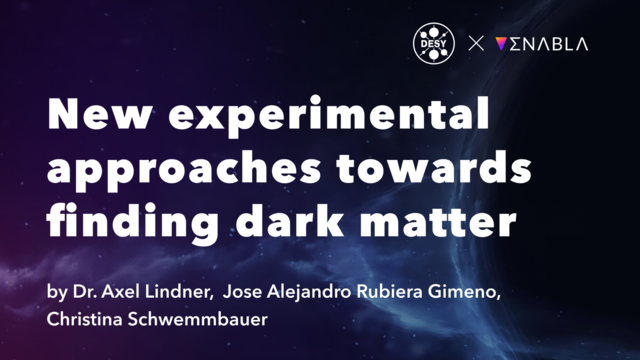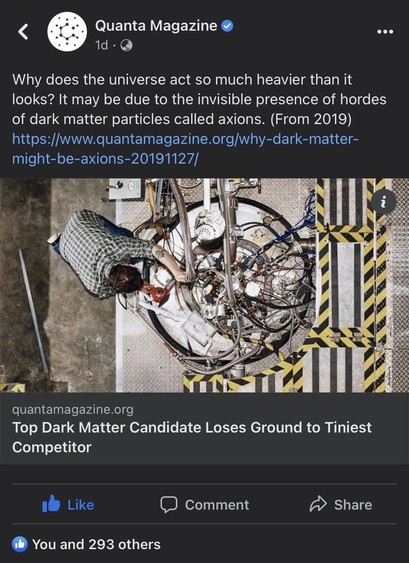Paige 🏳️⚧️ 🏳️🌈🔭📖🌹🌌 · @Paigethemiddleagedtransgirl
56 followers · 2036 posts · Server mas.toDaniel Fischer · @cosmos4u
1478 followers · 2884 posts · Server scicomm.xyzUltra-light #axions and the S8 tension - joint constraints from the cosmic microwave background and galaxy clustering: https://iopscience.iop.org/article/10.1088/1475-7516/2023/06/023 -> Astronomers discover new link between dark matter and 'clumpiness' of the universe: https://www.artsci.utoronto.ca/news/astronomers-discover-new-link-between-dark-matter-and-clumpiness-universe and https://www.dunlap.utoronto.ca/astronomers-discover-new-link-between-dark-matter-and-clumpiness-of-the-universe/
Cazzandro · @KodeGhinn
7 followers · 284 posts · Server qoto.orgScienceAlert · @ScienceAlert
327 followers · 141 posts · Server universeodon.com23-29 April 2023: This week in science: from wound-healing technology and the liquid core of Mars to dark matter investigations and more!
⚡🧠🟠🌲🔦🏔️
#TWIS
Biochip https://buff.ly/3mYhYr8
Alzheimer's https://buff.ly/3HfaPK1
Mars https://buff.ly/3Nk3CfG
Logjam https://buff.ly/41LMh3o
Einstein rings https://buff.ly/3oKwxiR
Andes https://buff.ly/3V3JK23
#health #WoundHealing #electricity #bioelectronics #Alzheimers #sleep #neuroscience #brain #BrainScience #neurology #space #Mars #MarsCore #SpaceDiscoveries #environment #logjam #CarbonStorage #physics #EinsteinRings #GravitationalLensing #DarkMatter #axions #nature #AndesMountains #TectonicPlates #geology #science #ScienceAlert #STEM
#twis #health #woundhealing #electricity #bioelectronics #alzheimers #sleep #neuroscience #brain #brainscience #neurology #Space #mars #marscore #spacediscoveries #environment #logjam #carbonstorage #physics #einsteinrings #gravitationallensing #darkmatter #axions #Nature #andesmountains #tectonicplates #geology #Science #sciencealert #stem
Steven Saus [he/him] · @StevenSaus
453 followers · 8156 posts · Server faithcollapsing.comFrom 21 Apr: No WIMPS! Heavy particles don’t explain gravitational lensing oddities - Enlarge / The red arcs at the right of center are background galaxies distorted by gravita... https://arstechnica.com/science/2023/04/gravitational-lensing-may-point-to-lighter-dark-matter-candidate/ #astronomy #axions #cosmology #dark-matter #particle-physics #science #wimps
#wimps #science #particle #dark #cosmology #axions #astronomy
Daniel Fischer · @cosmos4u
1366 followers · 2301 posts · Server scicomm.xyzAnomalies in Gravitational-Lensed Images Revealing Einstein Rings Modulated by Wavelike #DarkMatter: https://arxiv.org/abs/2304.09895 -> No WIMPS! Heavy particles don’t explain #GravitationalLensing oddities - detailed look at a lensed galaxy favors lighter particles called #axions: https://arstechnica.com/science/2023/04/gravitational-lensing-may-point-to-lighter-dark-matter-candidate/
#axions #gravitationallensing #darkmatter
· @pdougmc
26 followers · 982 posts · Server mastodon.cloud@WIMPS #Astronomy #DarkMatter #axions No WIMPS! Heavy particles don’t explain gravitational lensing oddities
Detailed look at a lensed galaxy favors lighter particles called axions. https://arstechnica.com/science/2023/04/gravitational-lensing-may-point-to-lighter-dark-matter-candidate/?comments=1&comments-page=1
#astronomy #darkmatter #axions
Tech news from Canada · @TechNews
489 followers · 13635 posts · Server mastodon.roitsystems.caArs Technica: Gravitational lensing may point to lighter dark matter candidate https://arstechnica.com/?p=1933677 #Tech #arstechnica #IT #Technology #particlephysics #DarkMatter #astronomy #cosmology #Science #axions #WIMPs
#Tech #arstechnica #it #technology #particlephysics #darkmatter #Astronomy #cosmology #science #axions #wimps
IT News · @itnewsbot
3142 followers · 257335 posts · Server schleuss.onlineGravitational lensing may point to lighter dark matter candidate - Enlarge / The red arcs at the right of center are background galaxies d... - https://arstechnica.com/?p=1933677 #particlephysics #darkmatter #astronomy #cosmology #science #axions #wimps
#wimps #axions #science #cosmology #astronomy #darkmatter #particlephysics
AutisticMumTo3 She/her · @AutisticMumTo3
71 followers · 536 posts · Server universeodon.comNew look at 'Einstein rings' around distant galaxies just got us closer to solving the dark matter debate
#EinsteinRings
#DarkMatter
#Galaxies
#FundamentalParticle
#WIMPs
#Axions
#Einstein
#EinsteinsTheory
#Gravity
#GravitationalLensing
#Amruth
https://phys.org/news/2023-04-einstein-distant-galaxies-closer-dark.html
#einsteinrings #darkmatter #galaxies #fundamentalparticle #wimps #axions #einstein #einsteinstheory #gravity #gravitationallensing #amruth
Enabla · @enabla
11 followers · 28 posts · Server mathstodon.xyz🌌 New #DarkMatter Lecture! 💫 Discover #axions, learn about the #ALPS II experiment & more from the #OpenAccess @DESYnews lecture at https://enabla.com/pub/686/about 🎥
🗣 Don't be shy; ask your questions on Enabla and get answers from the lecturers themselves! Let's learn together!🤩
What is dark matter, and what are some current methods scientists are using to detect it? In this lecture, we explore the topic of this elusive substance that makes up approximately 85% of the matter in the universe. We discuss the evidence for the existence of dark matter, including gravitational lensing and the stability of galaxies, as well as the challenges in detecting it due to its lack of interaction with ordinary matter. We then focus on a particular candidate for dark matter called axions and describe an experiment aimed at detecting them using high-power lasers and strong magnets cooled to extremely low temperatures. The ALPS II experiment will significantly improve the sensitivity to a possible axion signal and could therefore provide crucial insight into the nature of dark matter. We also briefly discuss other methods for detecting dark matter, such as observing astrophysical processes. Finally, we consider the implications of dark matter for our understanding of the universe and the future directions of research in this exciting field. The lecture was given during the DESY Ukraine Winter School in February 2023.
All Enabla lectures are #free & #OpenAccess. Please support us by sharing this post, following our account & asking questions on #Enabla. Thank you!🙏
#Physics #Astrophysics #StandardModel #HighEnergyPhysics #HEP #ParticlePhysics #GravitationalLensing #Cosmology #IAXO
#iaxo #cosmology #gravitationallensing #particlephysics #hep #highenergyphysics #standardmodel #astrophysics #physics #enabla #free #openaccess #alps #axions #darkmatter
weakly catlike intelligence · @cathodion
29 followers · 249 posts · Server mastodon.sdf.org“New Horizons probe may have observed light from decaying dark matter”
The probe was able to get a view unpbstructed by the glare from Solar System dust and found that “the [cosmic optical background] is almost twice as bright as would be expected from the latest galaxy survey“
The research team “suggests that this excess light could come from the decay of axions”, a hypothetical dark matter particle.
#astronomy #axions #DarkMatter #NewHorizons https://physicsworld.com/a/new-horizons-probe-may-have-observed-light-from-decaying-dark-matter/
#astronomy #axions #darkmatter #newhorizons
yeti · @yeti
51 followers · 110 posts · Server emacs.chAnton Petrov
Hubble Uncovers Mystery Glow Inside the Solar System, But What's Causing It?
https://www.youtube.com/watch?v=biCCNrTNk0s
#AntonPetrov #astronomy #axions #DarkMatter#mystery #solarsystem #ZodiacalLight
#antonpetrov #astronomy #axions #darkmatter #solarsystem #zodiacallight
Reymond Aguinaldo · @mondinspace
482 followers · 1317 posts · Server mastodon.social#Axions have a double motivation: they solve the 'strong CP problem' of the #StandardModel of elementary #Particles & they are a candidate for the #DarkMatter of the #Universe. The discovery of axions would answer many questions about dark matter & other #ParticlePhysics mysteries. Axions are also predicted by #StringTheory, or the idea that all the forces & particles in the universe are tied together as part of the same framework.
https://ui.adsabs.harvard.edu/abs/2017MPLA...3240003Y/abstract
#axions #StandardModel #particles #darkmatter #universe #particlephysics #stringtheory
Delano Massey · @delano
16 followers · 10 posts · Server newsie.socialI appreciate the love from my #introduction. Please welcome several members of the #Axios crew, fellow #Axions @russcontreras @tylerbuchanan @daniellealberti @kristaldixon who also joined this community.
#LocalNews
#introduction #axios #axions #localnews
Dr Ian Bailey · @irbailey
9 followers · 4 posts · Server qoto.orgHello All. As it says in my bio:
I am a lecturer in accelerator #physics at Lancaster University, UK and at the Cockcroft Institute of Accelerator Science and Technology.
My current active projects involve:
i) Using computer simulations to study polarised particle beams as tools to measure the properties of muons, as a member of Fermilab #muon g-2.
ii) Searching for very light 'dark matter' candidates such as #axions and related 'hidden-sector' particles by exploiting the properties of electromagnetic waves in metallic and dielectric structures. In particular working on the QSHS collaboration as part of the Quantum Technologies for Fundamental Physics initiative.
iii) Designing energy-efficient, compact particle #accelerators for a range of applications including as high-flux sources of x-rays and gamma rays.
#muon #accelerators #physics #axions





